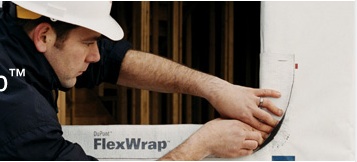
Articles
Codes & Standards
AAMA releases specification for self-adhering flashing
August 7, 2013 By Patrick Flannery
 August 7, 2013 – The American Architectural Manufacturers Association has released an updated standard that establishes minimum performance requirements for self adhering flashing surrounding exterior wall fenestration products. AAMA 711-13, Voluntary Specification for Self Adhering Flashing Used for Installation of Exterior Wall Fenestration Products also provides a method to determine the minimum width of the flashing products and to evaluate the influence of environmental factors on the installation of self adhering flashing products applied under typical field conditions.
August 7, 2013 – The American Architectural Manufacturers Association has released an updated standard that establishes minimum performance requirements for self adhering flashing surrounding exterior wall fenestration products. AAMA 711-13, Voluntary Specification for Self Adhering Flashing Used for Installation of Exterior Wall Fenestration Products also provides a method to determine the minimum width of the flashing products and to evaluate the influence of environmental factors on the installation of self adhering flashing products applied under typical field conditions.
 August 7, 2013 – The American Architectural Manufacturers Association has
August 7, 2013 – The American Architectural Manufacturers Association has
released an updated standard that establishes minimum performance
requirements for self adhering flashing surrounding exterior wall fenestration
products. AAMA 711-13, Voluntary Specification for Self Adhering
Flashing Used for Installation of Exterior Wall Fenestration Products also
provides a method to determine the minimum width of the flashing products
and to evaluate the influence of environmental factors on the
installation of self adhering flashing products applied under
typical field conditions.
“AAMA 711 is the only document dedicated to setting holistic material
standards for self adhering flashing used around windows and doors,”
says Jim Katsaros (DuPont Glass Laminating
Solutions), vice-chair of AAMA’s Flashing Task Group. “Using flashing
that meets this specification ensures that the flashing will have
sufficient peel adhesion, nail sealability and durability through the
anticipated exposure. The value of this specification is recognized by the
ICC Residential Code, as it is referenced in IRC Section R708.3, stating
that self adhered membranes used as flashing shall comply with AAMA 711.”
Updated from the 2007 version, “the most significant change made to AAMA
711 was the addition of a modified version of ASTM G155 Xenon Arc
Test as an alternative to ASTM G154 for accelerated weatherability
testing,” says Kim Flanary (Milgard Manufacturing, Inc.), chair
of AAMA’s Flashing Task Group. “AAMA 711 was re-opened in September of
2011 to add an option to test 4-inch-wide specimens in Section 5.3,
make general editorial changes in line with AAMA 712 and to review
the need to add a Flashing Sealant Compatibility section.”
AAMA 711 references important industry documents which include:
* AAMA 800-10, Voluntary Specifications and Test
Methods for Sealants
* ASTM C734-06(2012), Standard Test Method for
Low-Temperature Flexibility of Latex Sealants After Artificial Weathering
* ASTM C765-97(2011), Standard Test Method for
Low-Temperature Flexibility of Preformed Tape Sealants
* ASTM D3330/3330M-04(2010), Standard Test Method for Peel Adhesion
of Pressure-Sensitive Tape
* ASTM E331-00(2009), Standard Test Method for Water Penetration of
Exterior Windows, Skylights, Doors, and Curtain Walls by Uniform Static
Air Pressure Difference
* ASTM E631-06, Standard Terminology of Building Constructions
* ASTM E2112-07, Standard Practice for Installation of
Exterior Windows, Doors and Skylights
* ASTM G155-05a, Standard Practice for Operating Xenon Arc Light
Apparatus for Exposure of Non-Metallic Materials
“I wish to thank all of the [Flashing] Task Group members for their hard
work in updating and publishing this important standard,” says
Flanary.
AAMA 711-13, along with other AAMA publications, may be
purchased from AAMA’s Publication store.
Related Link
www.aamanet.org
Print this page
Leave a Reply